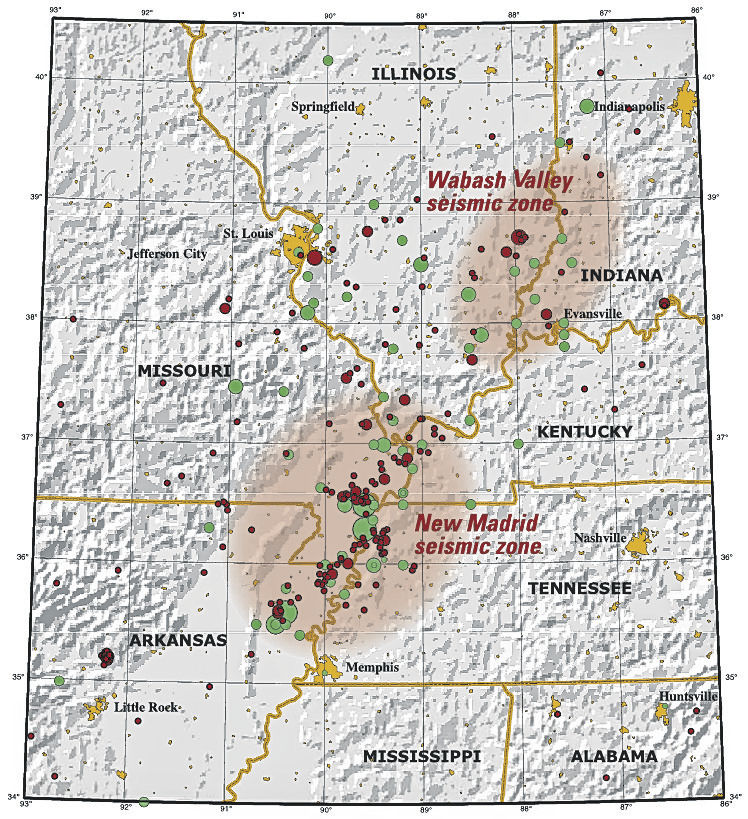When the shaking began on a cold winter night in December 1811, the ground rose and fell, and deep cracks opened within it.
Large sand blows formed, destroying farmland in some areas and causing landslides in others.
Along the Mississippi River, trees fell into the water, and large waves capsized boats. High river banks collapsed, and entire islands later disappeared.
The earthquake, a magnitude 7.5, was one of most powerful quakes to ever hit the central United States, including Indiana, and could be felt as far away as Washington, D.C. It was part of a series of at least three quakes between December 1811 and February 1812. They would later become synonymous with the region where they occurred, dubbed the New Madrid earthquakes, named for the town of New Madrid, in what is now southeastern Missouri.
Now, more than 200 years later, thousands of people — including Johnson County residents — take part in an annual nationwide earthquake drill designed to educate the public about the importance of taking immediate action when an earthquake occurs. It is called the Great Central U.S. Shakeout, and will take place Thursday at schools across the county.
Center Grove, Creekside, Indian Creek and Webb elementary schools; Indian Creek Intermediate School; and Central Nine Career Center are participating. Edinburgh schools is also participating as the only district in the county registered to have a district-wide drill.
The annual multi-state earthquake drill is run by the Central United States Earthquake Consortium, a partnership between the federal government and the eight states most affected by earthquakes in the central United States — Alabama, Arkansas, Illinois, Indiana, Kentucky, Mississippi, Missouri and Tennessee, according to the organization.
Since 2000, more than 22 earthquakes have affected Indiana. The state has several fault lines, most of them concentrated in the southwestern part of the state in the Wabash Valley Seismic Zone, said Polly Root Sturgeon, education outreach coordinator at the Indiana Geological and Water Survey.
Seismic zones are areas where earthquakes tend to focus, and the Wabash zone encompasses portions of southwestern Indiana and southeastern Illinois, the USGS says.
More than 310,000 Hoosiers are registered to take part in the drill, from K-12 schools to health care facilities to the Indiana Department of Homeland Security; 265 schools across the state are participating this year, according to the consortium.
Creekside Elementary School in Franklin has participated in the drill for years. The school began participating after Principal Mark Heiden saw something about the Great Central U.S. Shakeout in a school safety email the state sends out to educators, he said.
Many parents do not realize that earthquakes can happen in Indiana, so the drill teaches children what to do during an earthquake. The drill is real quick and simple — drop, cover and hold on — and by doing it each year, it makes an impact on students, Heiden said.
“Indiana like other places can get earthquakes. This is just another practice we use in case of an emergency,” he said.

The last time an earthquake struck Indiana was earlier this year, on June 17, in the western Indiana town of Bloomingdale, about 30 miles north of Terre Haute. The earthquake registered a magnitude of 3.8, and had a Level V, or moderate, intensity based on the Modified Mercalli Intensity Scale, according to the USGS. The 10-point scale evaluates earthquakes by measuring responses such as people awakening, furniture movement, chimney damage and total destruction.
During the June quake, weak shaking was felt as far east as Franklin and Greenwood, according to the USGS.

One of the most memorable earthquakes to affect Johnson County since 2000 occurred on April 18, 2008, when a magnitude 5.2 quake struck five miles northwest of Mount Carmel, Illinois — 25 miles southwest of Vincennes.
The quake was felt as far north as Milwaukee, Wisconsin, and as far west as Des Moines, Iowa. Weak to light shaking was reported throughout Johnson County, according to the USGS.
The Mount Carmel quake dominated news coverage on April 19, 2008, and was the main story in the Daily Journal’s weekend edition. County residents reacted with shock and surprise as many couldn’t believe an earthquake had happened here.
“I knew it was an earthquake. The house shook for 10 seconds,” Edinburgh resident Greg Roberts said at the time.
One Greenwood resident who lived in Greenwood Village South, a six-story tower of senior-living apartments until it was torn down in 2013, could feel the building shift after the quake.
“At first I thought it was the wind, but there was no wind. Then I started to get ready to go,” resident Katie Giguere said at the time.
Very little damage was reported throughout the county. Minor damage was reported throughout Indiana, Illinois, Kentucky and Missouri, according to the consortium.
Some chimneys and roofs collapsed and gravestones shifted as a result of the quake, Sturgeon said. The quake was followed by six aftershocks.
There is always a possibility of another quake in Indiana’s future. However, earthquakes are impossible to predict. Indiana has deeply buried faults which are constantly under pressure and move. The movement is what causes the quakes, Sturgeon said.
“We just don’t know, but the geology of the region makes it likely we will continue to have earthquakes,” she said.
The central United States, including Indiana, is located in the third most seismically active region of the country, behind Hawaii and Alaska, which many people don’t realize.
People should take part in earthquake drills, and practice drop, cover and hold on, to prepare for the inevitable. During an earthquake, you should drop to the floor, get under a sturdy table and hold on until the shaking stops, Sturgeon said.
Many of the safety tips for earthquakes apply to other disasters as well, she said.
Hoosiers should also pack a disaster kit that includes perishable items, similar to what is suggested to prepare for other disasters should also make a plan with family members about where to meet outside the building after it happens, similar to what is suggested when a house fire occurs.
RECENT EARTHQUAKES
Here is a look at earthquakes that have affected Indiana since 2008. For brevity, this list only includes earthquakes that registered a magnitude 2.5 or higher.
April 18, 2008 – Mount Carmel, Illinois
At 5:36 a.m., a magnitude 5.2 earthquake occurred approximately 5 miles northwest of Mount Carmel, Illinois, 25 miles southwest of Vincennes. The maximum perceived intensity was Level VII, or very strong, on the Modified Mercalli Intensity Scale. The earthquake was felt throughout the states of Illinois, Indiana and Kentucky, and as far away as Missouri, Michigan, Ohio and Wisconsin.
The first aftershock of the quake was felt less than half-an-hour after the first quake. At 6:03 a.m., a 2.5 magnitude quake was reported three miles northwest of Mount Carmel.
Within 90 minutes, four more aftershocks were reported.
The last aftershock was felt at 10:14 a .m., and was a magnitude 4.7 earthquake. The maximum perceived intensity was Level VII, or very strong, on the Modified Mercalli Intensity Scale.
April 21, 2008 – Mount Carmel, Illinois
At 12:38 a.m., a magnitude 4.0 earthquake occurred near Mount Carmel, Illinois, 25 miles southwest of Vincennes.
Dec. 30, 2010 – Greentown, Indiana
At 7:55 a.m., a magnitude 3.8 earthquake occurred 5 miles from Greentown, Indiana. No damage or injuries were reported.
Aug. 23, 2011 – Mineral, Virginia
At 1:51 p.m., a magnitude 5.8 earthquake occurred near Mineral, Virginia, 84 miles southwest of Washington, D.C. More than 243 Indiana citizens reported feeling the quake.
Jan. 26, 2012 – Emma, Indiana
At 5:35 p.m., a magnitude 3.0 earthquake occurred near Emma, Indiana, 15 miles south-southwest of Sturgis, Michigan. No damage or injuries were reported.
May 10, 2012 – Bicknell, Indiana
At 5:07 p.m., a magnitude 2.7 earthquake occurred near Bicknell, Indiana, 10 miles north-northeast of Vincennes and 40 miles northwest of Jasper.
Another earthquake was reported less than an hour later at 5:54 p.m. The quake was listed as a magnitude 3.1 earthquake. No damage or injuries were reported from either quake.
Sept. 19, 2017 – Albion, Illinois
At 7:47 a.m., a magnitude 3.8 earthquake occurred near Albion, Illinois, 28 miles southwest of Vincennes. No damage or injuries were reported.
Aug. 9, 2020 – Sparta, North Carolina
At 8:07 a.m., a magnitude 5.1 earthquake occurred near the Virginia-North Carolina border, 2.5 miles southeast of Sparta, North Carolina. Residents in Indiana, Ohio, Kentucky, Illinois and Michigan reported shaking from the quake.
June 17, 2021 – Bloomingdale, Indiana
At 3:18 p.m., a magnitude 3.8 earthquake occurred near the Indiana-Illinois border, 1.9 miles west of Bloomingdale. Residents in Indiana, Illinois, Kentucky and Ohio reported shaking from the quake.
Source: Indiana Geological and Water Survey; U.S. Geological Survey
HOW TO PARTICIPATE
Here is how you can participate in the earthquake drill, and how you can learn more about Indiana’s seismic hazards.
Great Central U.S. ShakeOut earthquake drill
When: 10:21 a.m. Thursday
How to get involved: To learn more about the ShakeOut, or to plan your own drill at your business or home, visit www.shakeout.org/centralus/index.html
Dig Deeper: Earthquake Preparedness webinar
What: Dig Deeper is a webinar that will look at Indiana’s seismic hazards and teach people how to prepare for them. The webinar will be live and recorded, and will follow the ShakeOut drill. The webinar is hosted by the Indiana Geological and Water Survey.
When: 11 a.m. to noon Thursday
How to watch: The webinar will be on Zoom, and can be accessed at iu.zoom.us/j/86239927916





